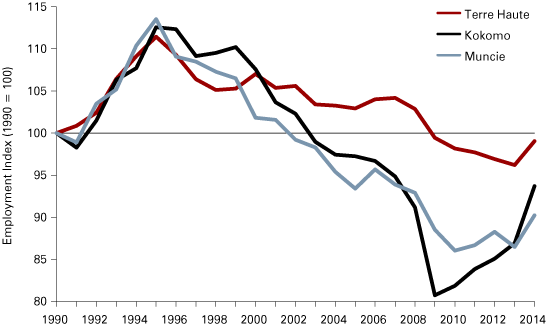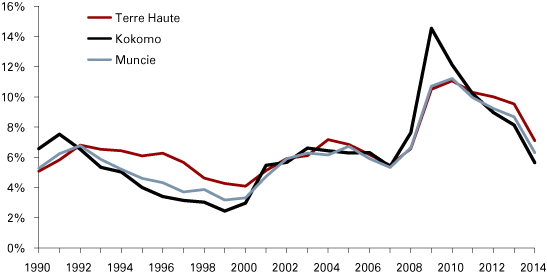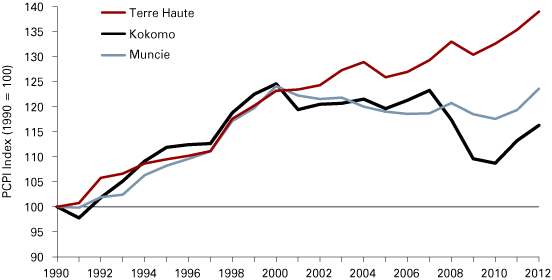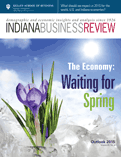Terre Haute Forecast 2015
Professor of Economics, Indiana State University
Associate Professor of Economics, Rose-Hulman Institute of Technology
“That’s equivalent to being the best hockey player in all of Ecuador.”
– Charles Emerson Winchester III
The snooty MASH character from the 1970s and 1980s television show pretty much wrapped up the sentiment for this year’s Terre Haute Outlook, which is “at least we’ve done better than Kokomo and Muncie.”
One need not have lived in Indiana for 25 years to know that the three most economically troubled metro areas since the 1990s have been Kokomo, Muncie and Terre Haute. While Indianapolis boasts nearly 35 percent more jobs today than in 1990, these three communities have lost jobs (Terre Haute: -1 percent; Kokomo: -6 percent; Muncie: -10 percent).
Indianapolis’s unemployment rate has been consistently lower than Terre Haute’s (2.1 points), Kokomo’s (1.7 points) and Muncie’s (1.6 points) for that same 25-year period. However, there is one economic measure, real per capita personal income (PCPI), where Terre Haute has outperformed Indiana’s capital. In terms of real PCPI growth since 1990, Terre Haute’s 39 percent increase actually exceeds Indianapolis (34 percent)—and substantially exceeds that of Muncie (24 percent) and Kokomo (16 percent).
So, though Terre Haute’s place as an Indiana economic basket case is well documented, the explanation for why Terre Haute would have fared so well in terms of personal income isn’t. A stab at that explanation and what these data may mean for Terre Haute’s economy in 2015 will fill out this year’s edition of Terre Haute’s outlook.
Figures 1 through 3 clearly show a similar employment and unemployment path for the three economically troubled metropolitan statistical areas (MSAs). Kokomo clearly bore the brunt of the Great Recession, but the paths were largely the same.
Figure 1: Employment Relative to 1990 Levels in Indiana’s Three Most Economically Troubled MSAs

Note: 2014 data are August preliminary numbers.
Source: U.S. Bureau of Labor Statistics
Figure 2: Unemployment Rates in Indiana’s Three Most Economically Troubled MSAs

Note: 2014 data are August preliminary numbers.
Source: U.S. Bureau of Labor Statistics
With regard to real PCPI, those paths diverge in 2000 (see Figure 3). While Muncie and Kokomo stagnated from 2000 through the beginning of the Great Recession, Terre Haute’s PCPI climbed, despite the shuttering of both Columbia House and Pfizer.
Figure 3: Real Per Capita Personal Income Relative to 1990 Levels in Indiana’s Three Most Economically Troubled MSAs

Source: U.S. Bureau of Economic Analysis
Part of the answer as to why Terre Haute’s real per capita personal income rose when other struggling cities saw declines may lie in the “per capita” aspect of this particular measure. Since 1990, each of the depressed communities have been largely stagnate in terms of population (Terre Haute: +3.4 percent; Kokomo: +2.3 percent; Muncie: -2.0 percent), while Indianapolis has seen its population rise rapidly (+37 percent). It is possible that a portion of the weaker communities’ populations have sought better opportunities elsewhere in the state.
Part of the answer may also relate to the mix of employment opportunities in Terre Haute. Manufacturing employment has declined 12 percent, while retail employment has declined by 31 percent (largely from the loss of Columbia House). The relatively stable employment in education and health care—and the fact that incomes in the education and health care sectors have repeatedly beaten inflation—has clearly lead to an increase in the proportion of the MSA’s employee compensation coming from this sector. Though not necessarily showing up as a greater number of jobs in these sectors, incomes for employees at Indiana State, Rose-Hulman, the Federal Bureau of Prisons, Union Hospital and Terre Haute Regional Hospital have at least been stable and have frequently beaten inflation. The former two employers are explained by record enrollments and the latter two by the aging of the region's population.
What all of this suggests is that Terre Haute’s status as a struggling economic community may be undergoing a modification. Perhaps that is only because there are so few opportunities in the lower-paying employment categories that this group is predisposed to disproportionately leave the community. Still, the abandonment of these folks from Terre Haute is somewhat slower than that which is occurring in Kokomo and Muncie. That isn’t much of a bragging right, nor is it a prescription for broadly based prosperity or a thriving community, but it does suggest that the remaining Hautians will have a decent year in 2015 as the causal trends are likely to continue for a while.
As a result, the forecast for the Terre Haute economy is for slowly declining rates of unemployment, despite a slowly declining number of total jobs, and a rising level of average incomes as the healthy sectors of the Terre Haute economy continue to do quite well.




